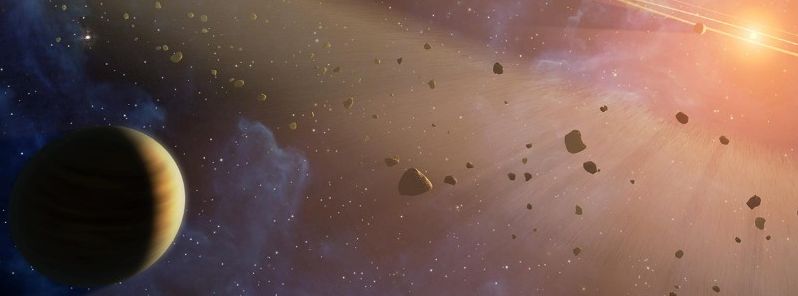Massive cloud of comets causing unexplained dip in a distant star’s glow

Kepler space telescope has spotted an unusual dip in a distant star's glow which might be caused by a massive cloud of comets orbiting the star.
Kepler telescope has been observing the same patch of sky for four years, searching for stars immersed in a bright glow. This glow appears as orbiting planet crosses in front of the star, and astronomers are able to gain information about the planet by measuring its size and timing.
A website Planet Hunters allows citizen scientists to inspect the data by eye in an effort to notice anything unusual. Data gathered from the KIC 8462852 star was particularly strange and a number of people have labeled it as "bizarre" and "curious".
Usually, planets block their star's light for only a few hours or days in regular interval that correspond to the duration of their orbit time. However, the star in question has had two small dips in 2009, a large, asymmetric week-long dip in 2011 and a series of many dips for three months in 2013, some of which have reduced the star brightness for as much as 20%.
“It was kind of unbelievable that it was real data,” said Tabetha Boyajian of Yale University,leader of the team of astronomers investigating the signal. After the data was re-checked, the scientists agreed the signal must be real. “We were scratching our heads. For any idea that came up there was always something that would argue against it.”
Researchers have concluded the star must be covered by lumps of dust, however the source of the dust has remained unknown, as collisions between two larger space bodies wouldn't be able to produce all of the dips observed in starlight.
After considering all the possibilities, the team has concluded it must be a family of exocomets that veered close to the star and were broken up by its gravity that were responsible for producing large amounts of dust and gas in the process. It turns out if the comets are on an eccentric orbit passing in front of the star approximately every 700 days, further breaking up and spreading out as they go, that would explain all the dips observed in the data.
More information is necessary to understand the true nature of this unusual signal. The observations have been a bit disrupted due to Kepler's malfunction, so the team is planning to continue with observations in May 2017.
The star is about 50% bigger than the Sun, so if the explanation proves to be correct, the dust comet cloud would be quite big, and would certainly provide an impressive sight. For comparison, if similar phenomena would take place in our solar system it would absorb a significant amount of sunlight.
The research was published in the Monthly Notices of the Royal Astronomical Society on September 11, 2015.
The Earth gets meteor showers when passing through the space debris left behind in interplanetary space by passing comets. If there was a planet in the KIC 8462852 system, someone residing on such a world would witness a spectacular light show, according to Boyajian, as "the scale of the meteor shower would be huge, like cosmic-scale fireworks."
Sources: New Scientist, Monthly Notices of the Royal Astronomical Society (MNRAS)
Reference:
- Planet Hunters X. KIC 8462852 – Where's the flux? – T.S. Boyajian et al – MNRAS (2015) – arXiv:1509.03622 [astro-ph.SR]
Featured image: Distant star system, Artist's impression. Credit: NASA

Commenting rules and guidelines
We value the thoughts and opinions of our readers and welcome healthy discussions on our website. In order to maintain a respectful and positive community, we ask that all commenters follow these rules.